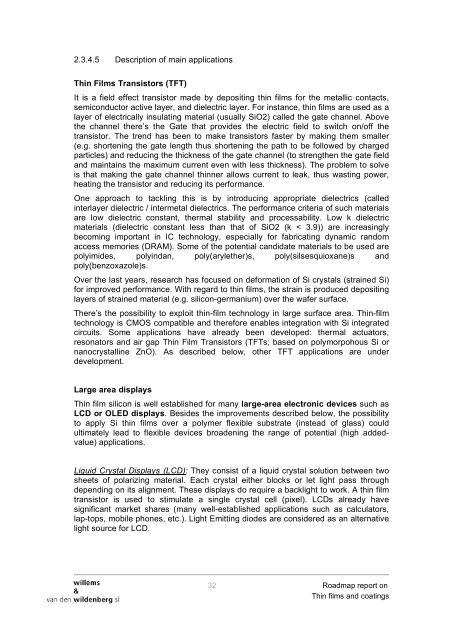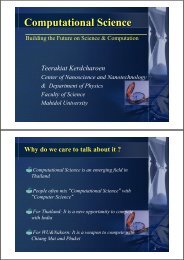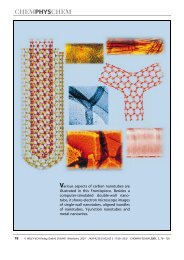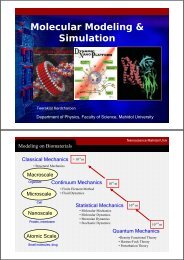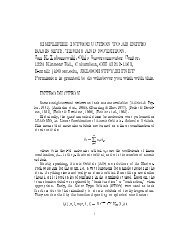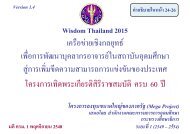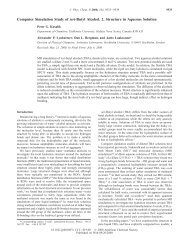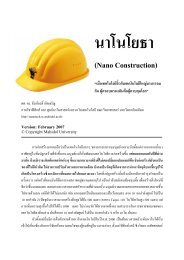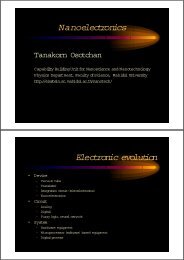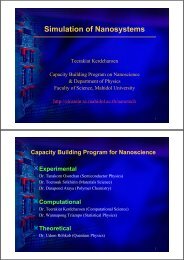'Thin films & coatings' Roadmap - Nano Mahidol
'Thin films & coatings' Roadmap - Nano Mahidol
'Thin films & coatings' Roadmap - Nano Mahidol
You also want an ePaper? Increase the reach of your titles
YUMPU automatically turns print PDFs into web optimized ePapers that Google loves.
2.3.4.5 Description of main applications<br />
Thin Films Transistors (TFT)<br />
It is a field effect transistor made by depositing thin <strong>films</strong> for the metallic contacts,<br />
semiconductor active layer, and dielectric layer. For instance, thin <strong>films</strong> are used as a<br />
layer of electrically insulating material (usually SiO2) called the gate channel. Above<br />
the channel there’s the Gate that provides the electric field to switch on/off the<br />
transistor. The trend has been to make transistors faster by making them smaller<br />
(e.g. shortening the gate length thus shortening the path to be followed by charged<br />
particles) and reducing the thickness of the gate channel (to strengthen the gate field<br />
and maintains the maximum current even with less thickness). The problem to solve<br />
is that making the gate channel thinner allows current to leak, thus wasting power,<br />
heating the transistor and reducing its performance.<br />
One approach to tackling this is by introducing appropriate dielectrics (called<br />
interlayer dielectric / intermetal dielectrics. The performance criteria of such materials<br />
are low dielectric constant, thermal stability and processability. Low k dielectric<br />
materials (dielectric constant less than that of SiO2 (k < 3.9)) are increasingly<br />
becoming important in IC technology, especially for fabricating dynamic random<br />
access memories (DRAM). Some of the potential candidate materials to be used are<br />
polyimides, polyindan, poly(arylether)s, poly(silsesquioxane)s and<br />
poly(benzoxazole)s.<br />
Over the last years, research has focused on deformation of Si crystals (strained Si)<br />
for improved performance. With regard to thin <strong>films</strong>, the strain is produced depositing<br />
layers of strained material (e.g. silicon-germanium) over the wafer surface.<br />
There’s the possibility to exploit thin-film technology in large surface area. Thin-film<br />
technology is CMOS compatible and therefore enables integration with Si integrated<br />
circuits. Some applications have already been developed: thermal actuators,<br />
resonators and air gap Thin Film Transistors (TFTs; based on polymorpohous Si or<br />
nanocrystalline ZnO). As described below, other TFT applications are under<br />
development.<br />
Large area displays<br />
Thin film silicon is well established for many large-area electronic devices such as<br />
LCD or OLED displays. Besides the improvements described below, the possibility<br />
to apply Si thin <strong>films</strong> over a polymer flexible substrate (instead of glass) could<br />
ultimately lead to flexible devices broadening the range of potential (high addedvalue)<br />
applications.<br />
Liquid Crystal Displays (LCD): They consist of a liquid crystal solution between two<br />
sheets of polarizing material. Each crystal either blocks or let light pass through<br />
depending on its alignment. These displays do require a backlight to work. A thin film<br />
transistor is used to stimulate a single crystal cell (pixel). LCDs already have<br />
significant market shares (many well-established applications such as calculators,<br />
lap-tops, mobile phones, etc.). Light Emitting diodes are considered as an alternative<br />
light source for LCD.<br />
32 <strong>Roadmap</strong> report on<br />
Thin <strong>films</strong> and coatings


